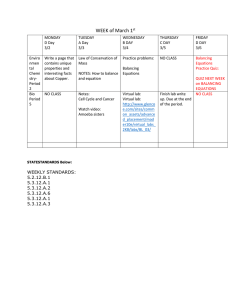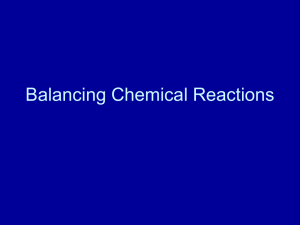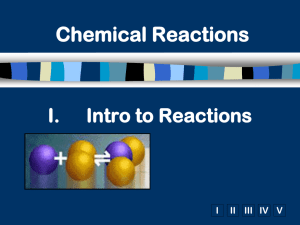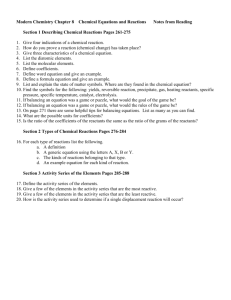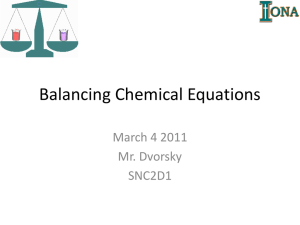balance chemical equations - Ms. Bergman's Classes at DCIS
advertisement
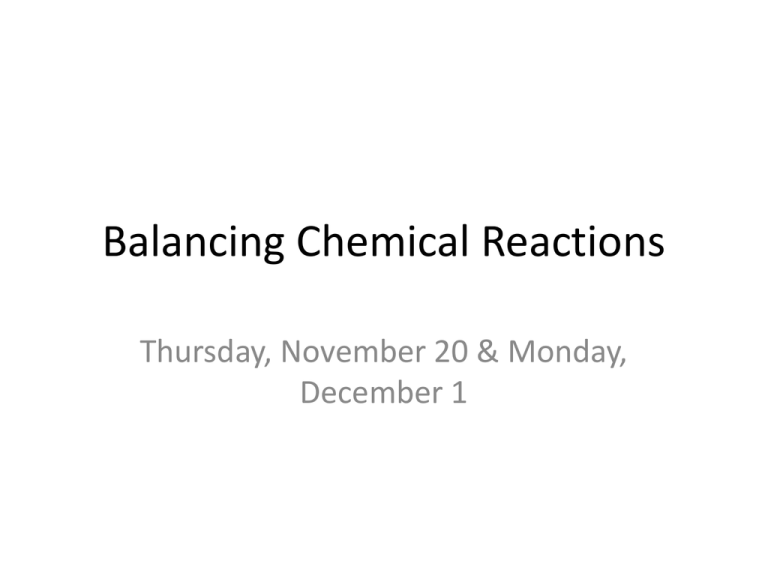
Balancing Chemical Reactions Thursday, November 20 & Monday, December 1 Do Now • What are the general equations for the 4 types of chemical reactions we learned about earlier this week? Types of Chemical Reactions • What are the general equations for the 4 types of chemical reactions we learned about earlier this week? 1. 2. 3. 4. Synthesis: A + B AB Decomposition: AB A + B Single Replacement: AB + C CB + A Double Replacement: AB + CD AD + CB Types of Reactions: SYNTHESIS A + B C Types of Reactions: DECOMPOSITION AB A + B Types of Reactions: SINGLE REPLACEMENT A + BC AC + B Types of Reactions: DOUBLE REPLACEMENT AB + CD DA + BC Objective • I can balance chemical equations using coefficients according to the Law of Conservation of Mass HONORS Chemical Reactions Lab Recap • Due Friday 11/25 • 3 types of reactions: synthesis, single replacement, and double replacement • Observations complete for the following reactions 1. Iron and sulfur 2. Copper and silver nitrate 3. Calcium chloride and sodium carbonate 4. Sodium bicarbonate and acetic acid Homework • Due Monday/Tuesday, December 1/2: balancing chemical equations Homework • Turn in: types of chemical reactions vocabulary foldable Agenda 1. 2. 3. 4. 5. 6. 7. Do Now, Objective (8 min) Law of Conservation of Mass Intro (8 min) Balancing Reactions Notes (6 min) Balancing Rxns Guided Practice (10 min) Balancing Rxns Game (10 min) Balancing Rxns Onion (15 min) Balancing Rxns Independent Practice (10 min) Law of Conservation of Mass Intro • Watch the video on the Law of Conservation of Mass. Then, write 1-2 sentences explaining why this is an important idea in our unit on chemical reactions. http://www.brainpop.com/science/matteran dchemistry/conservationofmass/ Think Pair Share • What does the law of conservation of mass say? • ¿Qué dice la ley de conservación de la masa? Foldable Notes: Subscripts N2 + 3 H2 2NH3 • Subscript: how many atoms of an element are in a molecule or compound • Subíndice: cuántos átomos de un elemento en una molécula o compuesto *subscripts can’t change! Foldable Notes: Coefficient Rb + S4 2RbS2 • Coefficient: represent the number of molecules or formula units that are involved in a reaction • Coeficiente: cuántas moléculas están involucradas en una reacción *coefficient can change! Thumbs Up, Thumbs Down N2 + 3H2 2NH3 Rb + S4 2RbS2 1. Is the first equation balanced? How do you know? - Yes. There are the same number of atoms of each element in the reactants and the products. 2 nitrogen atoms, and 6 hydrogen atoms 2. Is the second equation balanced? - No. There is 1 Rb atom in the reactants, and 2 in the products. It does not follow the law of conservation of mass Balancing Reactions: Guided Practice • You’ve just cashed your paycheck and you’re ready for a night out with your friends. You’ve got money- Why not splurge a little? The next morning you check your pockets to figure out how much you spent. WHOA! Where did your paycheck go?!? So you hunt a little find your receipts to piece together where your money has gone… Balancing Reactions: Guided Practice • You started with $150 – Below is a list of your expenses • $35 – dinner • $24.50 – movie tickets • $45 – shopping spree 1. How much money are you trying to account for? 2. How much is not accounted for? Balancing Reactions: Guided Practice • You started with $150 – Below is a list of your expenses • $35 – dinner • $24.50 – movie tickets • $45 – shopping spree 1. How much money are you trying to account for? $150 total 2. How much is not accounted for? $45.50 A Balancing Act • In chemical equations all of our atoms must be accounted for. • We call this the law of conservation of mass, in which no mass is created or destroyed. • A esto le llamamos la ley de conservación de la masa, en el que se crea ninguna masa o destruidos. • To make sure our work holds true, we balance chemical equations. Balancing Chemical Equations – Example 1 C5H10O + 7O2 5CO2 + 5H2O Element Reactants Products Carbon (C) 5 5 Hydrogen (H) 10 5*2 = 10 Oxygen (O) 14+1 = 15 5*2 +5*1 = 10+5 = 15 *When you have a coefficient in a chemical equation. Multiply the coefficient by the subscript to get the number of atoms of that element in the reaction. Balancing Reactions: Example 2 SnO2 + H2 Sn + H2O Element Tin (Sn) Oxygen (O) Hydrogen (H) Reactants Products This reaction is unbalanced. You need to change the COEFFICENTS to balance it and obey the law of conservation of mass! Balancing Reactions: Example 2 1SnO2 + 2H2 1Sn + 2H2O SnO2 + 2H2 Sn + 2H2O Guided Practice • Balance the reaction below using a ‘balancing table’ __Fe2O3 (s) + ___CO (g) ___Fe(l) + ___ CO2(g) Element Fe (iron) O (oxygen) C (carbon) # Atoms in Reactants # Atoms in Products Guided Practice ___H3PO4 + ____HCl ____PCl5 + ___H2O Element H (hydrogen) P (phosphorous) O (oxygen) Cl (chlorine) # Atoms in Reactants # Atoms in Products Guided Practice ___Na3PO4 + ___HCl ___ NaCl + ___H3PO4 Element Na (sodium) P (phosphorous) O (oxygen) H (hydrogen) Cl (chlorine) # Atoms in Reactants # Atoms in Products Balancing Reactions Game – 10 minutes • Go to Ms. Bergman’s website and play the ‘balancing reactions’ game for more practice balancing chemical equations 1. Write down the balanced chemical equations in your notes http://sbergman.weebly.com/chemistry-unit-3--chemical-reactions.html Balancing Reactions Recap • Chemical Reactions must have equal numbers of each type of atom on both sides of the reaction arrow • Reacciones químicas deben tener el mismo número de cada tipo de átomo en ambos lados de la flecha de reacción __Fe2O3 + __CO __Fe + __CO2 Fe2O3 + 3CO 2Fe + 3CO2 Balancing Reactions Onion Practice • Balance 5 chemical equations using your “onion” – The inside layer is the most difficult! – Write down all 5 balanced reactions in your notes – Use a balancing table to help as needed Element Reactants Products Onion Answers! 1. 2. 3. 4. 5. 6. 7. 2Fe + 3Cl2 2FeCl3 4Fe + 3O2 2Fe2O3 BaCl2 + Na2SO4 + H2O BaSO4 + 2NaCl Ca + 2H3N Ca(NH2)2 + H2 C4H6O3 + H2O 2C2H4O2 10HSiCl3 + 15H2O H10Si10O15 + 30HCl 6XeF4 + 12H2O 2XeO3 + 4Xe + 24HF + 3O2 Balancing Equations Practice • If you finish early work on your balancing reactions homework problems (#1-20) Balancing Equations Day 2 • Do Now, Objective (10 min) • Review steps of balancing equations (10 min) • Balancing equations whiteboard practice (10 min) • Balancing Equations Group Practice (15 min) • Independent practice balancing (20 min) • Balancing equations quiz (10 min) Do Now Balance the chemical equation below: H2 + O2 H2O Do Now Balance the chemical equation below: 2H2 + O2 2H2O Objective • I can balance chemical equations using coefficients according to the Law of Conservation of Mass on a balancing reactions quiz Homework Turn in: balancing chemical equations homework from before Thanksgiving Break Agenda 1. 2. 3. 4. 5. 6. Do Now, Objective (8 min) Review Balancing Reactions (10 min) Balancing Reactions Whiteboard Practice (10 min) Balancing Reactions with Partners (15 min) Balancing Reactions Independent Practice (20 min) Balancing Reactions Quiz (10 min) A Balancing Act • In chemical equations all of our atoms must be accounted for. • We call this the law of conservation of mass, in which no mass is created or destroyed. • A esto le llamamos la ley de conservación de la masa, en el que se crea ninguna masa o destruidos. • To make sure our work holds true, we balance chemical equations. Balancing Chemical Equations – Example 1 C5H10O + 7O2 5CO2 + 5H2O Element Reactants Products Carbon (C) 5 5 Hydrogen (H) 10 5*2 = 10 Oxygen (O) 14+1 = 15 5*2 +5*1 = 10+5 = 15 *When you have a coefficient in a chemical equation. Multiply the coefficient by the subscript to get the number of atoms of that element in the reaction. Balancing Reactions: Example 2 SnO2 + H2 Sn + H2O Element Tin (Sn) Oxygen (O) Hydrogen (H) Reactants Products This reaction is unbalanced. You need to change the COEFFICENTS to balance it and obey the law of conservation of mass! Balancing Reactions: Example 2 1SnO2 + 2H2 1Sn + 2H2O SnO2 + 2H2 Sn + 2H2O WHITEBOARD PRACTICE Balance the chemical reaction below: N2 + H2 NH3 WHITEBOARD PRACTICE Balance the chemical reaction below: KClO3 KCl + O2 WHITEBOARD PRACTICE Balance the chemical reaction below: NaCl + F2 NaF + Cl2 WHITEBOARD PRACTICE Balance the chemical reaction below: AlBr3 + K2SO4 KBr + Al2(SO4)3 WHITEBOARD PRACTICE Balance the chemical reaction below: CO2 + H2O C6H12O6 + O2 WHITEBOARD PRACTICE Balance the chemical reaction below: K + MgBr KBr + Mg WHITEBOARD PRACTICE Balance the chemical reaction below: HCl + CaCO3 CaCl2 + H2O + CO2 WHITEBOARD PRACTICE Balance the chemical reaction below: H2SO4 + NaNO2 HNO2 + Na2SO4 Balancing Reactions Group Practice • Working in groups of 2-3, use the reaction cards to balance reactions 1-12 on your activity sheet. • This activity is graded for accuracy. – 12 points for types of reaction – 12 points for correctly balancing the equation Independent Practice • Practice balancing chemical equations using either your Balancing Reactions Homework OR Chemical Equations & Reaction Types, Quiz • Complete your quiz silently. When you are finished, turn it in, and wait quietly until the end of class.

